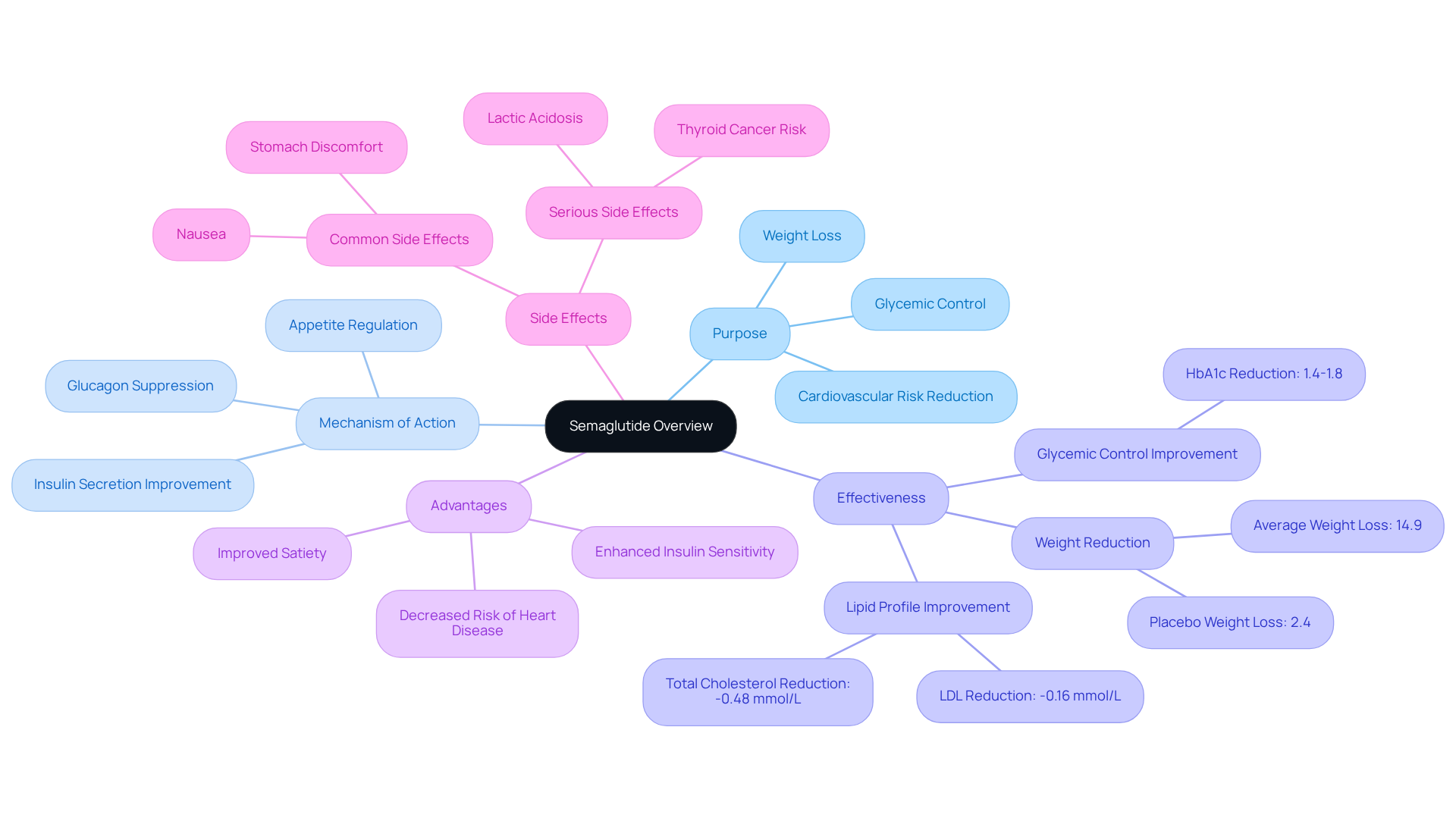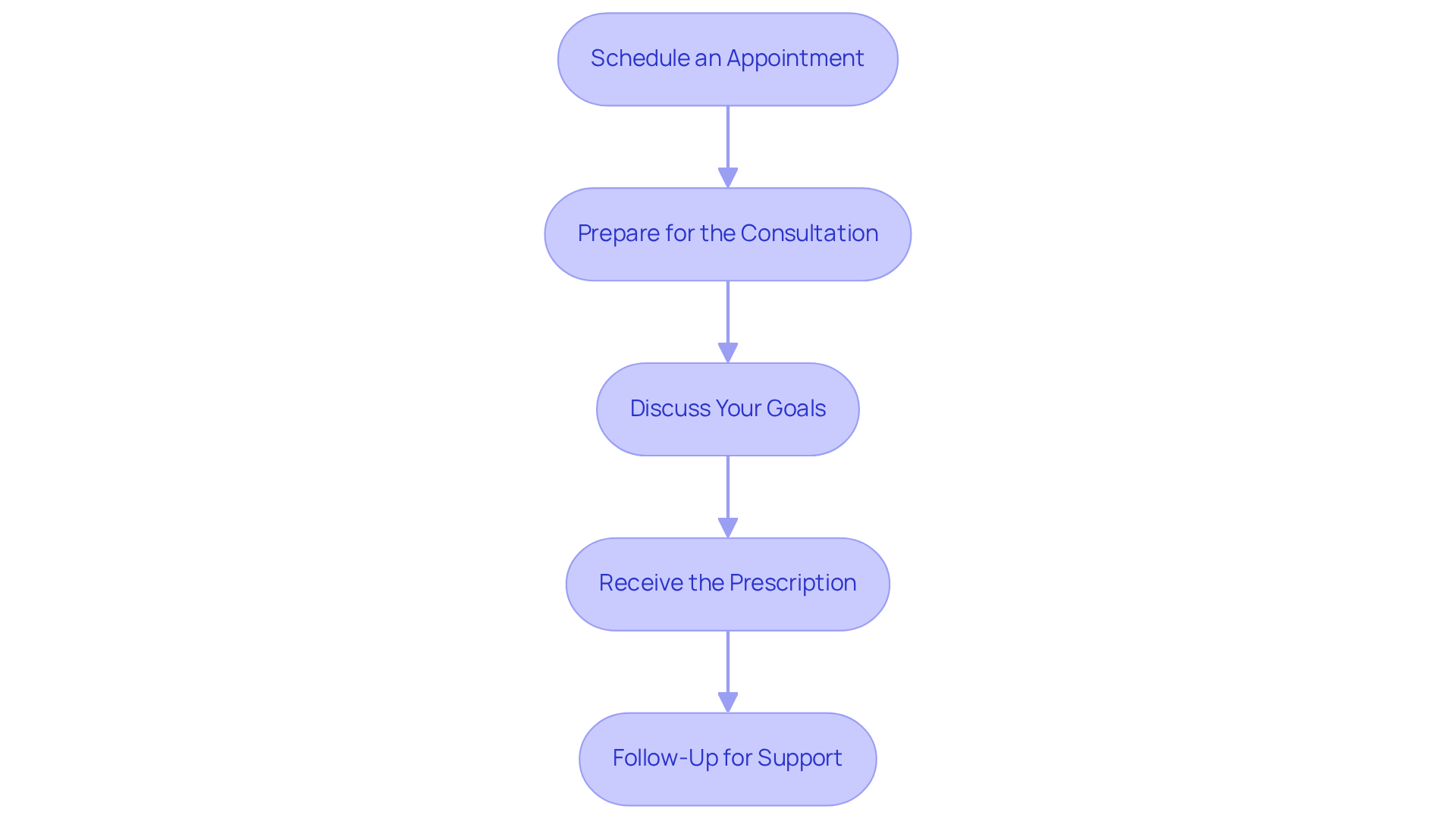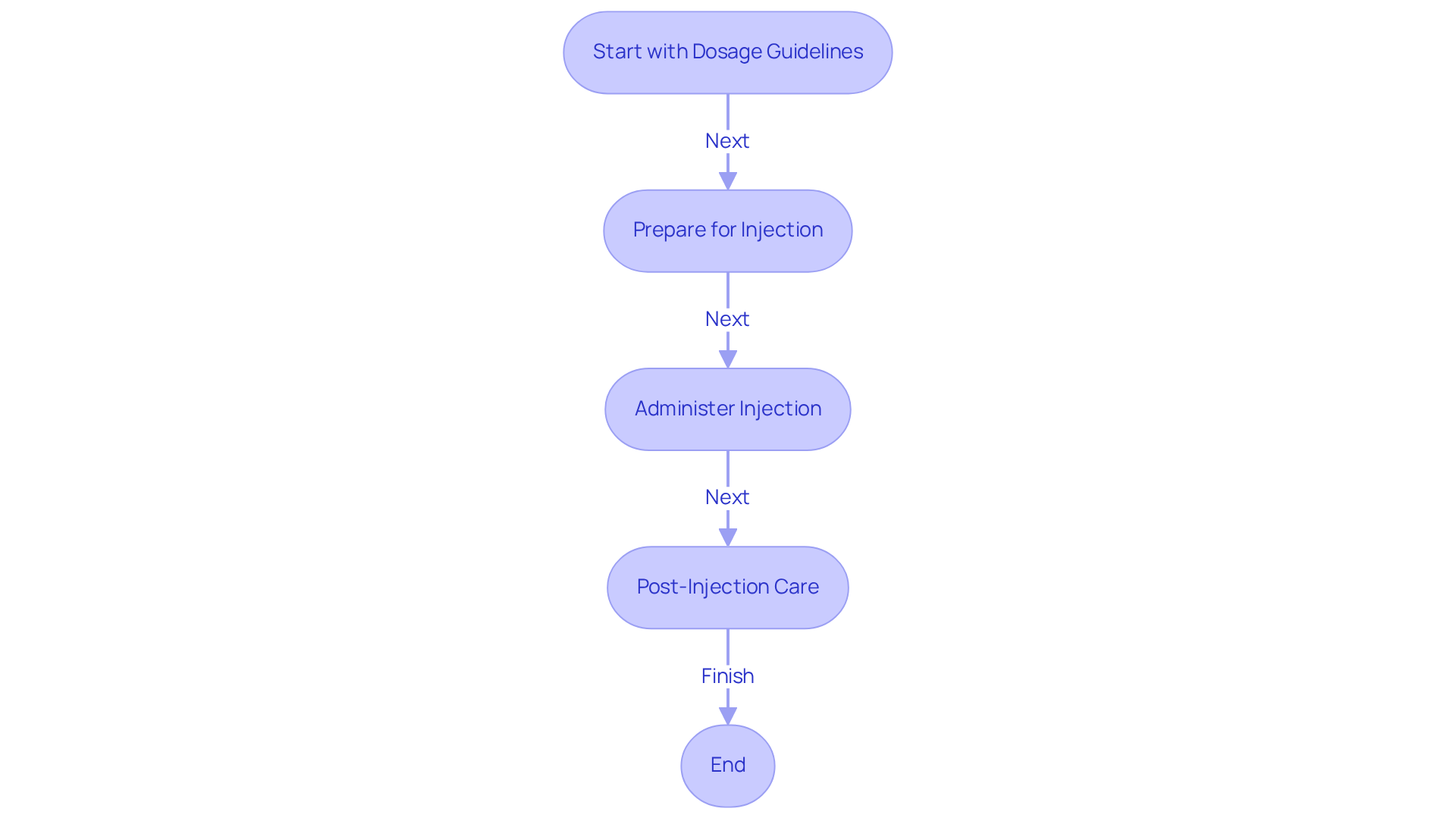Overview
This article highlights four essential steps to help you safely obtain a prescription for semaglutide:
- Schedule an appointment with a healthcare provider.
- Prepare for your consultation by gathering any questions or concerns you may have.
- During the discussion, share your personal weight loss goals openly.
- If appropriate, you will then receive the prescription to support your journey.
We understand that embarking on this path can feel overwhelming, which is why personalized treatment plans and ongoing monitoring are crucial. By ensuring your treatment is tailored to your needs, we can help you manage your weight and enhance your metabolic health effectively. Remember, we’re here for you every step of the way, and together, we can achieve your goals.
Introduction
Prescription semaglutide has emerged as a transformative solution for individuals grappling with weight management and type 2 diabetes. By mimicking the body’s natural hormones, it helps regulate appetite and enhance glucose metabolism. We understand that navigating this journey can feel overwhelming, and this guide offers a clear pathway to safely obtain this medication. We’ll detail essential steps, from scheduling a consultation to understanding dosage and administration.
However, as with any treatment, there are challenges to consider. How can you ensure that you are making informed decisions while effectively managing potential side effects? Together, we can explore these questions and find the best approach for you. Remember, you’re not alone in this journey; we’re here for you every step of the way.
Understand Semaglutide: Purpose and Mechanism of Action
Prescription semaglutide is a glucagon-like peptide-1 (GLP-1) receptor agonist that effectively mimics the action of a natural hormone in the body. It plays a crucial role in appetite regulation and glucose metabolism, which can be a significant concern for many on their weight loss journey. Prescription semaglutide helps reduce blood sugar levels by improving insulin secretion and suppressing glucagon release while also encouraging fat reduction. Imagine feeling less hungry and more satisfied after meals—this is precisely what prescription semaglutide is designed to achieve, making dietary changes easier and more manageable.
In clinical studies, the effectiveness of prescription semaglutide has been notably demonstrated. Participants experienced an average weight reduction of 14.9%, compared to only 2.4% in placebo groups. This impressive result is encouraging for those who may feel overwhelmed by their weight loss efforts. Furthermore, prescription semaglutide has been shown to improve glycemic control, with reductions in HbA1c levels of 1.4-1.8% for the 1.0 mg dose. Additionally, this medication has been found to lower Low-Density Lipoprotein levels by a mean difference of −0.16 mmol/L and total cholesterol levels by a mean difference of −0.48 mmol/L. It’s administered as an injection once a week, and we recommend ongoing monitoring of HbA1c levels every 3 to 6 months to ensure you’re on the right track.
While prescription semaglutide offers numerous advantages, such as enhanced insulin sensitivity and a decreased risk of heart disease, it’s essential to consider possible side effects. Some individuals may experience stomach discomfort, nausea, or, in rare cases, serious lactic acidosis. Understanding these aspects is crucial for making informed decisions about your health. Remember, we’re here for you as you navigate these choices.
Grasping how prescription semaglutide works and its practical factors can empower you in your journey towards achieving your slimming objectives and effectively managing type 2 diabetes. Together, we can achieve your goals, and with the right support and information, you can take confident steps forward.
Obtain a Prescription: Steps to Access Semaglutide
To obtain a prescription for semaglutide, follow these steps:
-
Schedule an Appointment: Start by booking an appointment with a healthcare provider, whether in-person or via telehealth. It’s important to ensure that the provider understands the medication and its role in significantly reducing weight and improving metabolic health.
-
Prepare for the Consultation: Gather your medical history, including any previous attempts at weight loss, current medications, and health issues that might affect your eligibility for treatment. This preparation will help create a personalized treatment plan that suits your needs.
-
Discuss Your Goals: During your appointment, openly share your weight loss goals and any concerns you may have. This conversation will assist the provider in determining how prescription semaglutide can help you manage your appetite and improve your blood sugar levels.
-
Receive the prescription semaglutide: If deemed appropriate, your healthcare provider will provide a prescription semaglutide. Make sure you understand the dosage and administration guidelines, which typically involve using a pen to deliver the medication once a week at the same time. Don’t hesitate to ask about rotating injection sites to prevent irritation.
For additional support, remember that we’re here for you. Reach out to Minimal via phone or email to discuss personalized body transformation consultations and assistance tailored to your unique journey.
Administer Semaglutide: Dosage and Usage Guidelines
Semaglutide is administered via a subcutaneous shot, and we want to ensure that you feel confident and safe in this process. By following these guidelines, you can achieve effective administration:
-
Dosage: Start with a dose of 0.25 mg once weekly for the first four weeks. Depending on how you respond and your comfort level, your healthcare provider may gradually increase the dosage to 0.5 mg, 1 mg, or up to a maximum of 2.4 mg weekly. This gradual approach helps manage any side effects and optimizes your weight loss results.
-
Administration Technique: When it’s time for your shot, choose a site on your abdomen, thigh, or upper arm. Clean the area with an alcohol swab to ensure safety. Pinch the skin to create a fold, insert the needle at a 90-degree angle, and gently inject the medication. It’s a good idea to rotate your injection sites weekly to avoid irritation.
-
Post-Injection Care: After you’ve injected, carefully remove the needle and apply light pressure to the site with a cotton ball or gauze. Be sure to dispose of the needle safely in a sharps container. This practice is vital for your safety and hygiene.
These methods have shown high success rates in clinical settings, with many individuals experiencing significant reductions in body mass and improvements in metabolic health. In fact, a study found that over 80% of those using this medication achieve substantial weight loss after 12 months, underscoring the effectiveness of this treatment. While gastrointestinal adverse events were reported in 82.2% of participants, most were mild to moderate and resolved without needing to stop treatment. As highlighted by Novo Nordisk, prescription semaglutide is associated with sustained, clinically relevant reductions in body weight, making it a valuable option for anyone seeking effective weight management solutions.
Remember, you’re not alone on this journey. Together, we can achieve your goals, and we’re here to support you every step of the way.
Manage Side Effects: Recognizing and Addressing Reactions
Prescription semaglutide, particularly in the form of Wegovy, is a medication thoughtfully designed for adults experiencing obesity (with a BMI of 30 kg/m² or greater) or overweight (BMI of 27 kg/m² or greater) who also have at least one weight-related health condition. This medication works by mimicking the action of glucagon-like peptide-1 (GLP-1), a hormone that plays a crucial role in regulating appetite and food intake. While Wegovy is generally well-tolerated, it’s important to be aware that some individuals may experience side effects. Common side effects include:
-
Nausea: This is the most frequently reported side effect associated with Wegovy. To help manage nausea, consider eating smaller, more frequent meals, avoiding rich or fatty foods, and steering clear of spicy or acidic items. Research suggests that consuming 1,500 mg of ginger daily can significantly alleviate nausea, making it a beneficial addition to your diet. Remember, nausea typically decreases as your body adjusts to prescription semaglutide over time.
-
Diarrhea and Constipation: These gastrointestinal issues can arise with Wegovy. Staying hydrated and consuming a balanced diet rich in fiber can help alleviate these symptoms. Regular hydration is vital, especially when experiencing these side effects, as dehydration can worsen nausea.
-
Site Reactions: Mild redness or swelling at the injection site may occur when using Wegovy. To ease this, rotate your administration sites and apply a cold compress if necessary.
Prescription semaglutide, commonly known as Wegovy, is administered via subcutaneous injection once a week, and studies have shown that combining prescription semaglutide with a reduced-calorie diet and increased physical activity can lead to significant weight loss. If you experience severe side effects such as persistent vomiting, severe abdominal pain, or signs of an allergic reaction (like rash or difficulty breathing), please seek medical attention immediately. Additionally, consulting a healthcare provider before trying anti-nausea medications or supplements is advisable to ensure your safety. Regular check-ins with your healthcare provider can help monitor your progress and address any concerns. Most side effects are mild and typically resolve within a few days or weeks, but being aware of potential severe side effects is crucial for ensuring your safety. Remember, we’re here for you, and together, we can achieve your goals.
Conclusion
Prescription semaglutide offers a powerful option for those looking to manage their weight and enhance their metabolic health. By mimicking the natural hormone GLP-1, it effectively regulates appetite and blood sugar levels, serving as a valuable ally in the fight against obesity and type 2 diabetes. It’s vital to understand how to safely obtain and utilize this medication to achieve your health goals.
In this guide, we’ve outlined the steps to access semaglutide in a clear and actionable manner:
- Schedule an appointment with a healthcare provider
- Discuss your personal goals
- Understand how to administer the medication
Each step is designed to empower you on your weight loss journey. We’ve also emphasized the importance of recognizing potential side effects and knowing how to manage them, ensuring a comprehensive approach to your treatment.
As you embark on this journey toward better health, it’s crucial to take informed and confident steps. Engaging with healthcare professionals and utilizing available resources can significantly enhance your experience with semaglutide. Embrace this opportunity to transform your health and well-being, and remember, we’re here for you—support is always available to help you navigate this path.
Frequently Asked Questions
What is semaglutide and what is its purpose?
Semaglutide is a prescription medication that acts as a glucagon-like peptide-1 (GLP-1) receptor agonist. It mimics the action of a natural hormone in the body to help regulate appetite and glucose metabolism, making it beneficial for those on a weight loss journey.
How does semaglutide work in the body?
Semaglutide helps reduce blood sugar levels by improving insulin secretion and suppressing glucagon release. It also encourages fat reduction, which can lead to decreased hunger and increased satisfaction after meals.
What are the clinical results associated with semaglutide?
In clinical studies, participants using semaglutide experienced an average weight reduction of 14.9%, compared to 2.4% in placebo groups. It also showed improvements in glycemic control, with reductions in HbA1c levels of 1.4-1.8% for the 1.0 mg dose.
How does semaglutide affect cholesterol levels?
Semaglutide has been found to lower Low-Density Lipoprotein (LDL) levels by a mean difference of −0.16 mmol/L and total cholesterol levels by a mean difference of −0.48 mmol/L.
How is semaglutide administered?
Semaglutide is administered as an injection once a week.
How often should HbA1c levels be monitored while on semaglutide?
It is recommended to monitor HbA1c levels every 3 to 6 months to ensure effective management of blood sugar levels.
What are the potential side effects of semaglutide?
Some individuals may experience stomach discomfort, nausea, or, in rare cases, serious lactic acidosis.
What additional benefits does semaglutide offer?
Semaglutide enhances insulin sensitivity and may decrease the risk of heart disease.
How can understanding semaglutide help in weight loss and diabetes management?
Grasping how semaglutide works can empower individuals to achieve their weight loss goals and effectively manage type 2 diabetes with proper support and information.





















